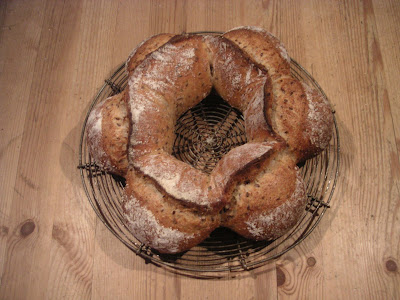I could withstand the Leader's "Alpine Baguettes" and decided to give Hamelman's "5-grain levain" a try. I thought that there can't be anything wrong with a bread that Hamelman himself describes as "one of the most delectable breads".
It's made of whole-wheat flour, bread and high gluten flour, and it includes a soaker (sunflower seeds, flaxseeds, chopped rye and oats.) In my case it includes as well some sesame seeds as I was running low on sunflower seeds and had to substitute some of them trough sesame. The fermentation process is speeded up by a little addition of yeast. I can't get high-gluten flour here in Switzerland, therefore I added 12 grams of Vital Wheat Gluten to the flour.
While I was letting the dough ferment for the first time, I was thinking about how I should shape this batch of bread. I felt a little bit bored by my "standard shape", the round loaf baked in the iron pot. I remembered the special Couronne shaping that I discovered a long time ago on wildyeastblog.com and that I had on my to-do-list for a long time. So I gave it a try. Thank you Susan, You're a great inspiration to me and your directions are clear and easy to follow, thanks for that!

Well, my Couronne doesn't exactly look as perfect as Susan's. It's a little bit out of shape because my "proofing banneton" was probably a little to big, so the balls didn't form a tight unit and moved around when I slided them into the oven.

That's the way I constructed my "banneton", inspired by Susan's description. I used the lid of my scouting cooking pot and a newspaper-ball. (I'm sorry for the bad image quality, all the good cameras are out today and I had to use my old camera, bought in 2002.) I covered this "banneton" with a well floured towel to prevent dough from sticking.
I had about 1.1 kg of dough alltogether, so I used 750 grams as recommended for the Couronne and made a small boule out of the rest.
To shape a couronne like the one above, divide the 750 grams of dough into six pieces of 100 and one piece of 150 grams. Shape the pieces into balls and let them rest for about 10 minutes. Roll the 150 gram - ball into a flat disk, about 15 cm wide. Place it over the newspaper ball, then arrange the other six balls seamside up around it. Then you have to cut a "star" into the flat doughpiece in the mittle with a sharp knife (look below or read Susan's instructions) and fold the "star-edges" over the balls.
Then let it proof as usual (cover it with a towel while proofing) and bake as you'd bake your recipe normally, maybe slightly shorter, because this shape is not as compact as a normal boule or batard.
I just tried two slices of the small boule - I planned on giving the couronne away, but now the person who was supposed to receive it isn't at home, therefore I put it into the freeze and I'll have it another time when more people are around. Right now, I'm not able to eat 750 grams of bread on my ownin a reasonable time. (as I said, everybody's gone, like the cameras . . .) I'm better off with 300 grams . . .
The flavor of the 5-grain levain is very good, as far as I can say right now. The bread is still somewhat warm. Nearly every bread tastes great while it's still warm. But I'm optimistic that the bread will taste great tomorrow for breakfast, as well.
I'm planning on baking this one again. Not only because it seems to be a tasty bread, but because I've got the feeling that I could simply do better. It was a hot day today, so the fermenting and proofing was difficult to get right, especially because the dough turned out to warm as well.
I'm sure that I'll shape Couronnes again. But then I'll probably scale the "banneton" a little bit down. The newspaperball more like 9 and the "pot lid" around 23 cm in diameter.